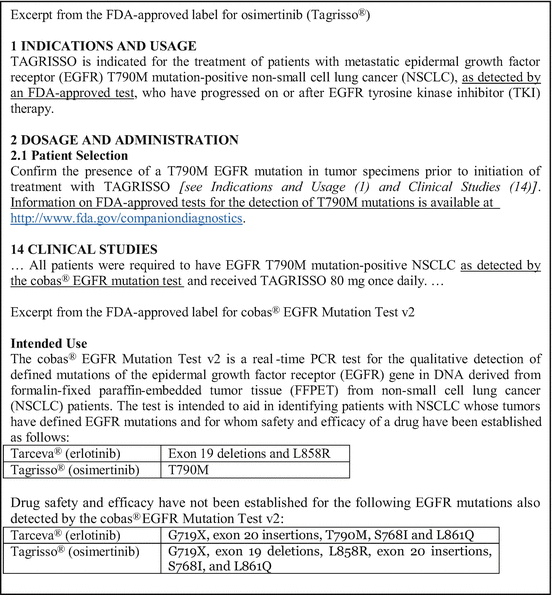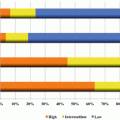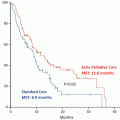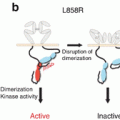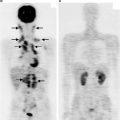Release date
Title
April 2005
Draft preliminary concept paper: Drug-Diagnostic Co-development Concept Paper
July 2011
Draft Guidance for Industry and Food and Drug Administration Staff: In Vitro Companion Diagnostic Devices
December 2012
Draft Guidance for Industry: Enrichment Strategies for Clinical Trials to Support Approval of Human Drugs and Biological Products
January 2013
Guidance for Industry: Clinical Pharmacogenomics: Premarket Evaluation in Early-Phase Clinical Studies and Recommendations for Labeling
July 2014
Guidance for Industry and Food and Drug Administration Staff: In Vitro Companion Diagnostic Devices [7]
An IVD companion diagnostic device could be essential for the safe and effective use of a corresponding therapeutic product to:
Identify patients who are most likely to benefit from a particular therapeutic result of product.
Identify patients likely to be at increased risk for serious adverse reactions as a result of treatment with a particular therapeutic product.
Monitor response to treatment for the purpose of adjusting treatment (e.g., schedule, dose, discontinuation) to achieve improved safety or effectiveness.
Identify patients in the population for whom the therapeutic product has been adequately studied, and found safe and effective, i.e., there is insufficient information about the safety and effectiveness of the therapeutic product in any other population.
The guidance describes that as a rule, pharmaceutical products and CoDx need to be developed and approved or cleared at the same time; for CoDx, PMA or 510(k) need to be submitted; and that for both pharmaceutical products and CoDx, regulations on usage of each are stated on their labels (package inserts).
As stated in the guidance, CoDx is not unequivocally defined as class III; however, the CoDx that have been approved by the FDA thus far are all approved as class III. A list of FDA-approved pharmaceutical products and the corresponding CoDx can be found on the website at http://www.fda.gov/CompanionDiagnostics.
Figure 7.1 shows one example of provided CoDx information for medical facilities – the FDA-approved label for osimertinib which was approved in the United States in November 2015 and its CoDx, the cobas® EGFR Mutation Test v2 [8, 9]. In the label for osimertinib, in the Indications and Usage section, the administration targets patients who were found to have the EGFR T790M mutation based on an FDA-approved testing method. The Dosage and Administration section describes FDA-approved testing methods for detecting EGFR T790M mutation, and the Clinical Studies section describes how patients targeted in the clinical trials were patients found to have EGFR T790M mutation through the cobas® EGFR Mutation Test. In the label for cobas® EGFR Mutation Test v2, the Intended Use section describes the definition of EGFR mutation, which established the drugs’ (erlotinib or osimertinib) safety and efficacy, and the Clinical Performance Evaluation section describes the clinical trial results that confirmed the clinical performance of the cobas® EGFR Mutation Test.
7.2.2 EU
In the EU, the approval of pharmaceutical products is carried out by the European Medicine Agency (EMA) in a unified manner. The approval of IVD, however, is beyond the charge of the EMA, and based on the In Vitro Diagnostic Medical Device Directive 98/79/CE, they are certified by a notified body certification system. By acquiring the CE mark (standard conformity mark), they are able to be manufactured and marketed within EU member countries, additional countries in the European Economic Area, as well as in Switzerland. In other words, in the EU, there is no established system for the evaluation of pharmaceutical products and CoDx at the same time. Therefore, guidance on CoDx in the EU does not include content on the review and approval of CoDx. However, recently, we have seen movements toward revising regulations, such as recommendations for guidance from the EMA regarding IVD. Table 7.2 shows the guidance list for CoDx in the EU.
Table 7.2
List of the guidance for CoDx in the EU
Release date | Title |
|---|---|
June 2010 | Draft; Reflection paper on co-development of pharmacogenomics biomarkers and assays in the context of drug development |
June 2011 | Draft; Reflection paper on methodological issues associated with pharmacogenomic biomarkers in relation to clinical development and patient selection |
August 2012 | Guideline on the use of pharmacogenetic methodologies in the pharmacokinetic evaluation of medicinal products |
7.2.3 Japan
In Japan, the Ministry of Health, Labour, and Welfare (MHLW) has jurisdiction over administration related to medicine, and the Pharmaceuticals and Medical Devices Agency (PMDA) carries out approval of pharmaceutical products and medical devices. Japanese laws on pharmaceutical affairs are based on the “Law for Ensuring the Quality, Efficacy, and Safety of Drugs and Medical Devices,” which was a 2014 amendment to the “Pharmaceutical Affairs Law” enacted in 1961. In July 2013, the MHLW published guidance on CoDx [10], and now simultaneous development and approval of pharmaceuticals and CoDx are required. The definition of CoDx in the Japanese guidance is nearly the same as in the FDA’s guidance.
7.3 CoDx for Lung Cancer
This section will summarize the FDA-approved pharmaceutical products and its corresponding CoDx for lung cancer. Table 7.3 shows the list of the FDA-approved CoDx for lung cancer.
Table 7.3
List of the FDA-approved CoDx for lung cancer
Drug trade name (generic name) | Drug approval date | Device trade name | Device manufacturer | Device approval date |
|---|---|---|---|---|
Xalkori (crizotinib) | 08/26/2011 | VYSIS ALK Break-Apart FISH Probe Kit | Abbott Molecular Inc. | 08/26/2011 |
Tarceva (erlotinib) | 11/18/2004 | cobas EGFR Mutation Test | Roche Molecular Systems, Inc. | 05/14/2013 |
Gilotrif (afatinib) | 07/12/2013 | therascreen EGFR RGQ PCR Kit | Qiagen Manchester, Ltd. | 07/12/2013 |
Xalkori (crizotinib) | 08/26/2011 | VENTANA ALK (D5F3) CDx Assay | Ventana Medical Systems, Inc. | 06/12/2015 |
Iressa (gefitinib) | 05/05/2003a | therascreen EGFR RGQ PCR Kit | Qiagen Manchester, Ltd. | 07/10/2015 |
07/13/2015 | ||||
Keytruda (pembrolizumab) | 10/02/2015 | PD-L1 IHC 22C3 pharmDx | Dako, North America, Inc. | 10/02/2015 |
Tagrisso (osimertinib) | 11/13/2015 | cobas EGFR Mutation Test v2 | Dako, North America, Inc. | 11/13/2015 |
7.3.1 CoDx for Epidermal Growth Factor Receptor-Tyrosine Kinase Inhibitors (EGFR-TKIs)
The development of first-generation EGFR-TKIs – gefitinib and erlotinib, which have been approved as first-line treatment of advanced NSCLC harboring activating EGFR mutations today – was full of twists and turns. When these drugs were introduced into the clinical setting, the mechanism of drug action and the drug targets was not well known. The subsequent discovery of the activating mutations of the EGFR gene as a biomarker to select patients who are most likely to have benefit from the therapy have had a great impact on the treatment of non-small cell lung cancer (NSCLC). It has taught us that the identification and validation of biomarkers was important factor in targeted therapy [11].
Second-generation EGFR-TKIs – afatinib and dacomitinib – irreversibly bind to tyrosine kinase of EGFR and other ErbB-family members. Afatinib also has been approved as first-line treatment of advanced NSCLC harboring activating EGFR mutations. Dacomitinib is under development. Third-generation EGFR-TKIs – osimertinib, rociletinib (CO-1686), BI 1482694 (previously named HM61713), and other agents – inhibit both EGFR-activating and resistance mutations, such as EGFR T790M. Osimertinib has been granted accelerated approval for the treatment of advancer NSCLC harboring EGFR T790M mutation.
7.3.1.1 Gefitinib (Iressa)/Therascreen® EGFR RGQ PCR Kit
Gefitinib was first-ever approved in Japan on July 2002 for “the treatment of the patients with inoperable or recurrent NSCLC” based on response rates from two phase II IDEAL 1 and 2 studies [12, 13], which were conducted with unselected NSCLC populations. In the United States, gefitinib had originally been granted accelerated approval in May 2003 for “patients with locally advanced or metastatic NSCLC after failure of both platinum-based and docetaxel” [14] based on phase II IDEAL 2 study. Other data included results of the phase III INTACT 1 and 2 studies [15, 16]; however, results from these studies showed no benefit from adding gefitinib to chemotherapy (cisplatin plus gemcitabine or carboplatin plus paclitaxel, respectively) in unselected NSCLC patients. Consequently, gefitinib was only approved for use as monotherapy. Confirmatory trial was conducted but failed to verify clinical benefit from gefitinib; the phase III ISEL study which investigated the efficacy of gefitinib as second-line or third-line treatment in unselected patients did not demonstrate improved overall survival (OS) for gefitinib compared with best supportive care [17], although OS benefit was observed in the subgroup of Asian patients. On June 2005, following that erlotinib had been approved by the FDA based on phase III NCIC CTG BR.21 study [18], the FDA limited the indication to “patients who were currently receiving and benefiting, or had previously benefited, from gefitinib” [19]. Finally, on April 2012, the FDA withdrew approval of a new drug application for gefitinib [20].
In parallel with these clinical trials, many biomarkers were tested such as EGFR expression detected by immunohistochemistry (IHC), EGFR amplification or polysomy detected by fluorescence in situ hybridization (FISH) or quantitative polymerase chain reaction (PCR), or activating EGFR mutations. It was not until 2004 when it was discovered that NSCLC patients with activating EGFR mutations in the EGFR kinase domain yielded better response to EGFR-TKI [21–23]. The discovery of EGFR mutations has great implications in NSCLC treatment. EGFR mutations are more common with adenocarcinoma histology, Asian, women, and nonsmokers [23–25], which brought the Phase III IPASS study [26]. The IPASS study was conducted in East Asia in NSCLC patients with clinical characteristics known to be associated with higher prevalence of EGFR mutations (adenocarcinoma histology, never of light smoker) and met the primary endpoint of demonstrating non-inferiority of gefitinib compared with carboplatin plus paclitaxel as first-line treatment in these patients in terms of progression-free survival (PFS), but Kaplan-Meier curves for PFS crossed, indicating nonproportional hazards. What was important was the result of subgroup analyses. In the subgroup of patients who were positive for EGFR mutations detected by using the scorpion ARMS method, PFS was significantly longer among those who received gefitinib than among those who received chemotherapy, whereas in the subgroup of patients who were negative for the mutation, PFS was significantly longer among those who received chemotherapy. In Korea, the First-SIGNAL study was conducted in NSCLC patients with similar clinical characteristics to the IPASS study but failed to demonstrate superiority of gefitinib compared with gemcitabine plus cisplatin as first-line treatment in terms of OS [27]. In the subgroup of patients with negative for EGFR mutations detected by using direct sequencing method, overall response rate was relatively high, which suggests higher false-negative rates.
After that, the phase III WJTOG3405 and NEJ002 studies comparing gefitinib to chemotherapy as first-line treatment in patients selected for the presence of tumor harboring EGFR mutations were conducted [28, 29]. In Japan, approval application of gefitinib changed to “the treatment of the patients with inoperable or recurrent NSCLC with EGFR mutations” based on the subgroup analysis from IPASS study, WJTOG3405, and NEJ002 study on November 2011 [30]. In USA, the FDA approved gefitinib in July 2015 [31] for “the first-line treatment of patients with metastatic non-small cell lung cancer (NSCLC) whose tumors harbor specific types of epidermal growth factor receptor (EGFR) gene mutations, as detected by an FDA-approved test” based on the result from the single-arm phase IV IFUM study [32] and the subgroup analysis from IPASS study. The IFUM study, tumor samples were tested retrospectively using the therascreen® EGFR RGQ PCR Kit, which was a real-time PCR test for qualitative detection of exon 19 deletions and exon 21 (L858R) substitution mutations of the EGFR gene in DNA derived from formalin-fixed paraffin-embedded (FFPE) NSCLC tumor tissue. The FDA also approved the therascreen® EGFR RGQ PCR as CoDx for gefitinib in July 2015 [33].
7.3.1.2 Erlotinib (Tarceva)/Cobas EGFR Mutation Test: Cobas® EGFR Mutation Test v2
Erlotinib was originally approved by the FDA in November 2004 [34] for “the treatment of patients with locally advanced or metastatic non-small cell lung cancer after failure of at least one prior chemotherapy regimen” based on data from the phase III BR.21 study comparing erlotinib to platinum-based doublet chemotherapy in term of OS in unselected previously treated patients with advanced NSCLC [35]. In the BR.21 study, the expression of EGFR protein but EGFR mutations had been reported that was associated with response [36]. There was possibly selection bias since the EGFR expression was evaluated in less than half of the study population. As well as gefitinib, other data included results of the phase III TALENT and TRIBUTE studies was also submitted; however, results from these studies showed no benefit from adding erlotinib to chemotherapy (cisplatin plus gemcitabine or carboplatin plus paclitaxel, respectively) in unselected NSCLC patients [37, 38]. Consequently, erlotinib was also only approved for use as monotherapy.
In case of erlotinib, probably because the initial phase III BR.21 study met the primary endpoint in unselected NSCLC patients, there was not so much confirmatory trial as gefitinib. In May 2013, the FDA approved erlotinib for “the first-line treatment of patients with metastatic non-small cell lung cancer (NSCLC) whose tumors have epidermal growth factor receptor (EGFR) exon 19 deletions or exon 21 (L858R) substitution mutations as detected by an FDA-approved test [39].” This approval was based on data from the phase III EURTAC study comparing erlotinib to platinum-based standard chemotherapy in untreated patients with advanced EGFR mutation-positive NSCLC whose tumors had EGFR exon 19 deletions or exon 21 (L858R) substitution mutations determined by a clinical trial assay [40]. Tumor samples were retrospectively tested by the cobas EGFR Mutation Test, which was a real-time PCR test for the qualitative detection of defined mutations of EGFR gene in DNA derived from FFPE tissue. This indication for erlotinib was approved concurrently with the cobas EGFR Mutation Test, the CoDx for patient selection [9].
7.3.1.3 Afatinib (Gilotrif)/Therascreen EGFR RGQ PCR Kit
Afatinib is a second-generation EGFR-TKI, which was approved by the FDA for “the first-line treatment of patients with metastatic non-small cell lung cancer (NSCLC) whose tumors have epidermal growth factor receptor (EGFR) exon 19 deletions or exon 21 (L858R) substitution mutations as detected by an FDA-approved test” in July 2013 [41]. This approval was based on data from the phase III LUX-Lung 3 study comparing afatinib to cisplatin plus pemetrexed in patients with metastatic NSCLC with EGFR mutations determined by a clinical trial assay [42]. Tumor samples were retrospectively tested by the therascreen EGFR RGQ PCR Kit. Concurrent with this application, the FDA approved the therascreen EGFR RGQ PCR Kit for detection of EGFR exon 19 deletions or exon 21 (L858R) substitution mutations as the CoDx [43].
7.3.1.4 Osimertinib (Tagrisso)/Cobas® EGFR Mutation Test v2
Osimertinib is a third-generation EGFR-TKI. The FDA granted accelerated approval to osimertinib for “the treatment of patients with metastatic epidermal growth factor receptor (EGFR) T790M mutation-positive non-small cell lung cancer (NSCLC), as detected by an FDA-approved test, who have progressed on or after EGFR tyrosine kinase inhibitor (TKI) therapy” in November 2015 [8]. This accelerated approval was based on objective response rate from two single-arm studies (AURA Extension and AURA 2) in patients with metastatic EGFR T790M mutation-positive NSCLC who had progressed on prior systemic therapy, including an EGFR-TKI. All patients were required to have EGFR T790M mutation-positive NSCLC as detected by the cobas® EGFR Mutation Test. The FDA simultaneously approved the cobas® EGFR Mutation Test v2.
7.3.1.5 Liquid Biopsy-Based CoDx for EGFR Mutations Detection
On November 2014, the EMA extended the label of gefitinib to include the detection of EGFR mutations in circulating tumor DNA (ctDNA) from a blood (plasma) sample if a tumor sample is not evaluable [44]. This update was based on data from the IFUM study, which assessed EGFR mutation status in tumor and ctDNA samples derived from plasma, using the therascreen EGFR RGQ Plasma PCR kit. Following that, on January 2015, the therascreen EGFR RGQ Plasma PCR kit received CE mark as the first-ever liquid biopsy-based CoDx for EGFR mutations detection.
The utility of liquid biopsy methods is still being developed, and it is to be noted that the current gold standard in detecting EGFR mutation is tissue biopsy. The liquid biopsy methods have not yet been approved as CoDx for lung cancer in the USA and Japan.
7.3.2 CoDx for Anaplastic Lymphoma Kinase (ALK) Inhibitors
Crizotinib is first-generation ALK inhibitor approved for ALK-positive NSCLC. Second-generation ALK inhibitors – ceritinib, alectinib, and brigatinib – are designed to have more potency against ALK. Ceritinib has received accelerated approval, alectinib has been approved, and brigatinib is under development. Third-generation ALK inhibitors – lorlatinib and other agents – are designed to have efficacy against ALK mutants. Lorlatinib and other agents are also under development.
7.3.2.1 Crizotinib (Xalkori)/The Vysis ALK Break-Apart FISH Probe Kit
In August 2011, the FDA granted accelerated approval to crizotinib for “the treatment of patients with locally advanced or metastatic non-small cell lung cancer (NSCLC) that is anaplastic lymphoma kinase (ALK)-positive as detected by an FDA-approved test [45].” This accelerated approval was based on response rates from two single-arm PROFILE 1005 and 1001 [46] studies.
In PROFILE1005 study, ALK-positive NSCLC was identified using the Vysis ALK Break-Apart FISH Probe Kit, which was a qualitative test to detect rearrangements involving the ALK gene via FISH in FFPE NSCLC tissue specimens. In PROFILE 1001 study, ALK-positive NSCLC was identified using a number of local clinical trial assays. The FDA approved the Vysis ALK Break-Apart FISH Probe Kit to detect the presence of an ALK gene rearrangement concurrently with the approval of crizotinib.
Subsequently, on November 2013, the FDA has granted regular approval for crizotinib for “the treatment of patients with metastatic non-small cell lung cancer (NSCLC) whose tumors are anaplastic lymphoma kinase (ALK)-positive as detected by an FDA-approved test” based on data from the phase III PROFILE 1007 study comparing crizotinib to pemetrexed or docetaxel in patients with ALK-positive metastatic NSCLC who were previously treated with one platinum-based chemotherapy regimen [47]. On September 2015, the FDA approved the label update including data from the phase III PROFILE 1014 study comparing crizotinib to pemetrexed with cisplatin or carboplatin in previously untreated ALK-positive metastatic NSCLC patients [48]. In both PROFILE 1007 and 1014 studies, patients were required to have ALK-positive NSCLC as identified by the Vysis ALK Break-Apart FISH Probe Kit.
7.3.2.2 Ceritinib (Zykadia)
Ceritinib is a second-generation ALK inhibitor. The FDA approved ceritinib under accelerated approval for “anaplastic lymphoma kinase (ALK)-positive metastatic non-small cell lung cancer (NSCLC) who have progressed on or are intolerant to crizotinib” on April 2014 [49]. This approval was based on data from the phase I ASCEND-1 study [50]. The X2101 study enrolled patients who had previously received crizotinib; therefore, all patients had been tested for ALK rearrangement by the Vysis ALK Break-Apart FISH Probe Kit. In X2101 study, ALK positivity was verified retrospectively by local test. This indication for ceritinib was approved without CoDx.
7.3.2.3 Alectinib (Alecensa)
Alectinib was first approved in Japan on July 2014 for “ALK fusion gene-positive, unresectable, recurrent or advanced non-small cell lung cancer” [51] based on response rates from the Japanese phase I/II AF-001JP study [52]. In AF-001JP study, ALK inhibitor-naïve patients were enrolled, and ALK fusion gene was detected using IHC for FFPE specimens, reverse transcription PCR (RT-PCR) for unfixed specimens, or both [53]. Alectinib has been approved as first-line treatment for ALK rearrangement NSCLC, and both IHC and RT-PCR methods were approved as CoDx for alectinib in Japan.
Stay updated, free articles. Join our Telegram channel

Full access? Get Clinical Tree


